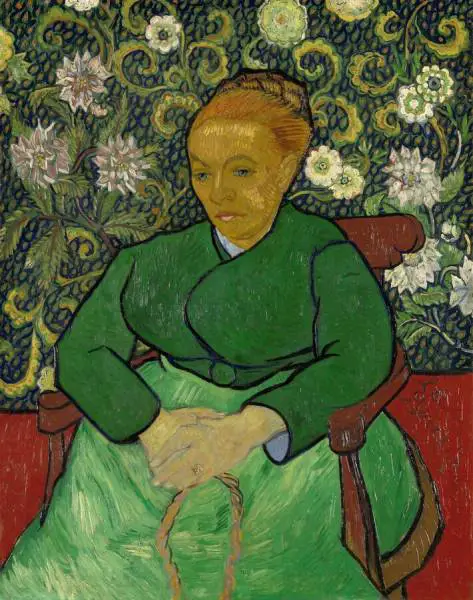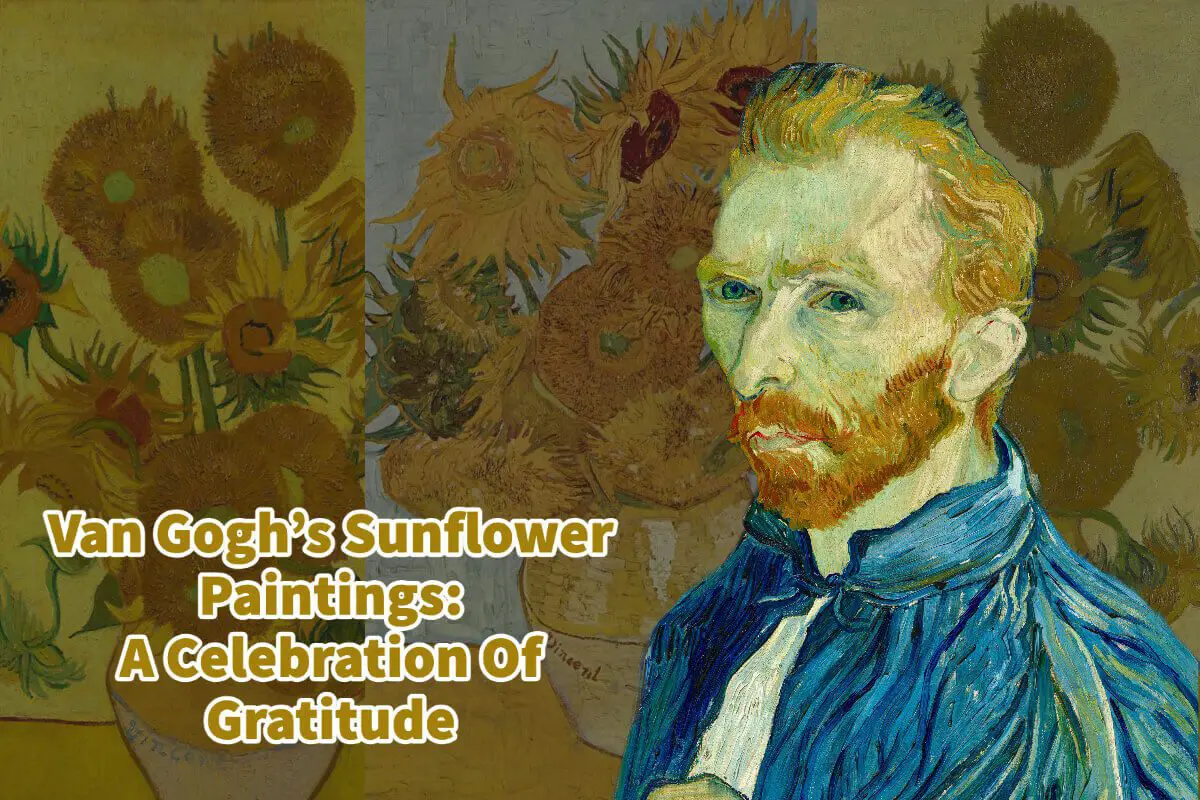Vincent Van Gogh’s Sunflower paintings remain one of my favorite series of paintings. When I was a child, my mother had a printed copy of one of the sunflower paintings in our kitchen.
The Sunflower series of paintings by Vincent van Gogh undoubtedly stand as some of his most renowned and cherished works of art. Painted in the scenic town of Arles in southern France between 1888 and 1889, these vibrant masterpieces have enthralled art enthusiasts across the globe. Van Gogh’s creative exploration of a singular color palette featuring captivating variations of yellow demonstrates his artistic prowess. It reveals his eloquence and ability to convey profound emotions through his brushstrokes.
Table of Contents
- Vincent Van Gogh’s Sunflower Paintings: A Celebration Of Gratitude In Shades Of Yellow
- Frequently Asked Questions
- Related Questions
Vincent Van Gogh’s Sunflower Paintings: A Celebration Of Gratitude In Shades Of Yellow
Vincent van Gogh’s Sunflower paintings are among his most famous and beloved works. Created in Arles, in the picturesque region of southern France, between 1888 and 1889, these vibrant masterpieces have captivated art enthusiasts worldwide. Van Gogh’s innovative use of a single color—variations of yellow—showcased his artistic prowess and eloquence.
Read on as we will delve into the significance of Van Gogh’s Sunflower paintings, their unique connection to the artist, and explore the journey of these iconic floral representations and some little-known facts about these iconic paintings.
Van Gogh’s Fascination With Sunflowers
Like many other artists of his time, Van Gogh ventured into still-life paintings, but he approached the genre with a unique perspective. After experimenting with different flowers, he discovered his affinity for sunflowers.

Despite being considered coarse and unrefined by his contemporaries, Van Gogh was drawn to their rustic beauty, even in their mature, withered state. These beautiful flowers became the central theme in several of his works, allowing Van Gogh to express his artistic vision in a distinct and captivating manner.
The Symbolism And Gratitude In Sunflowers For Vincent Van Gogh
For Van Gogh, the sunflower paintings held a profound significance—they represented gratitude. The artist believed the sunflower symbolized thankfulness and appreciation with its bright, vibrant petals.
This sentiment was so powerful that Van Gogh hung the first two paintings in the room of his dear friend, Paul Gauguin, who stayed with him in the famous Yellow House. Gauguin, recognizing the essence of Van Gogh’s artistry, considered the sunflowers quintessentially Vincent.

As a testament to their deep connection, Gauguin requested one of the sunflower paintings as a gift, a gesture that Van Gogh hesitated to fulfill initially but later created two loose copies, one of which now resides in the Van Gogh Museum in Amsterdam, Holland.
Multiple Versions Of Van Gogh’s Sunflowers
Contrary to popular belief, Van Gogh didn’t limit himself to a single depiction of sunflowers in a vase. Hee painted five different versions of this composition.

These iconic artworks from Tokyo to Amsterdam are now displayed in museums worldwide. Unfortunately, one of the versions was lost in Japan during a bombing in World War II, leaving behind a void in the collection of these treasured masterpieces.
However, the remaining paintings serve as a testament to Van Gogh’s commitment to exploring the potential of this subject matter.
Van Gogh’s Color Experiments And The Sunflowers
Van Gogh’s sunflower paintings were more than just representations of the natural world. They also served as experiments in color. Inspired by the vivid palettes of the Impressionists, which he discovered during his time in Paris, Van Gogh sought to infuse his work with a newfound vibrancy.
He gradually transitioned from traditional color schemes to more extreme contrasts, creating visually striking and emotionally evocative compositions. Through his sunflower paintings, Van Gogh pushed the boundaries of color and paved the way for future artistic innovations.
The Sunflowers’ Role In Van Gogh’s Artistic Journey
The significance of sunflowers in Van Gogh’s life extended beyond the mere subjects of his paintings. These radiant blooms played a pivotal role in his personal and artistic journey.
When Gauguin planned to join Van Gogh in the South of France, the latter eagerly decorated the guest bedroom with several still lifes of sunflowers. This act was a testament to their friendship and mutual artistic admiration.
Moreover, Van Gogh intended to create a triptych by combining some flowers in his paintings with his portrait “Woman Rocking the Cradle.” The intention behind this triptych was to symbolize gratitude—a profound emotion that Van Gogh believed connected the nurturing qualities of a mother, represented by the portrait, with the sunflowers’ vibrant beauty and life force.

Van Gogh’s Sunflower paintings are an enduring testament to his artistic genius and unique perspective on the world. These iconic works showcase his mastery of color and brushwork and encapsulate his profound emotions and personal journey. Through his exploration of sunflowers, Van Gogh found a symbol of gratitude and a means of expressing his appreciation for the beauty and inspiration surrounding him.
The five different versions of Sunflowers in a Vase, displayed in museums worldwide, bear witness to the lasting impact of Van Gogh’s art. Their vibrant hues and expressive brushstrokes continue to captivate viewers, inviting them to immerse themselves in the artist’s vision and experience his passion for capturing the essence of nature.
Van Gogh’s Sunflower paintings serve as a reminder that beauty can be found in the simplest of things. They encourage us to cultivate gratitude and appreciate the small joys that enrich our lives.
These radiant flowers, forever intertwined with Vincent’s legacy, remind us of the power of art to transcend time and touch the depths of the human spirit.

So, the next time you encounter a sunflower, take a moment to contemplate its vibrant petals, its delicate seeds, and the intricate dance of colors that Van Gogh immortalized on canvas. Let it remind you of the profound gratitude and appreciation that the artist intended to convey through his masterpieces.
Like Vincent, we can find solace, inspiration, and beauty in the simplest things and profound gratitude in the sunflower.
Anita Louise Art is dedicated to art education, great artists, and inspiring others to find and create their art. We love art that uplifts and inspires. #ArtToMakeYouSmile! #ArtToMakeYouHappy!
If you want to see any of my art, you can find out more by clicking here. If you are interested in what inspires me and my paintings, you can discover more by clicking here.
We have a free newsletter and would love you to be part of our community; you can subscribe to the newsletter by clicking here. If you have any questions, I would be happy to talk to you. You can reach me, Anita, by clicking here.
Subscribe to our Anita Louise Art YouTube Channel, filled with great videos and information by clicking here.
Join us for our podcast “5 Minutes With Art.” Spend just 5 minutes a week with us to discover and learn about great art and artists. You can find out more about our podcast by clicking here.
Frequently Asked Questions
Why did Van Gogh choose sunflowers as the subject of his paintings?
Van Gogh was drawn to the symbolism of sunflowers, representing gratitude and admiration. The vibrant colors and bold shapes appealed to his artistic sensibilities, making them an ideal subject for his expressive style.
How many paintings are there in Van Gogh’s Sunflower series?
The Sunflower series consists of a total of five paintings. Van Gogh created these masterpieces during his time in Arles, and each painting offers a unique perspective on the subject.
What inspired Van Gogh to paint the Sunflower series in Arles, France?
The beauty of the southern French town of Arles and its picturesque landscapes inspired Van Gogh’s Sunflower series. The vibrant colors and abundant sunlight in this region influenced his choice of subject and palette.
What is the significance of the color yellow in Van Gogh’s Sunflower paintings?
The predominant use of yellow in the Sunflower series is symbolic of Van Gogh’s emotional and psychological state. Yellow, often associated with warmth and positivity, reflects his pursuit of happiness and gratitude during a challenging period in his life.
Are all the paintings in the Sunflower series identical, or are there noticeable differences?
While the general theme of sunflowers remains constant, each painting in the series is unique. Van Gogh experimented with composition, color variations, and brushstroke techniques, resulting in distinct interpretations of the same subject.
How did the Sunflower paintings impact Van Gogh’s legacy as an artist?
Van Gogh’s Sunflower series is considered a hallmark of his artistic career. These paintings showcase his mastery of color, texture, and emotional expression, solidifying his reputation as a visionary artist. They continue to be celebrated and studied worldwide.
Did Van Gogh intend for the Sunflower paintings to convey a specific message or emotion?
Yes, Van Gogh aimed to convey a sense of gratitude and admiration through his Sunflower paintings. The vibrant and intense colors, along with the dynamic brushstrokes, are a visual expression of his deep emotions and appreciation for life.
Where are the original Sunflower paintings located today?
The five paintings from Van Gogh’s Sunflower series are housed in various museums around the world. Notable locations include the Van Gogh Museum in Amsterdam, the National Gallery in London, and the Neue Pinakothek in Munich.
How did Van Gogh’s personal struggles influence the creation of the Sunflower series?
Van Gogh faced numerous personal challenges, including mental health issues and financial difficulties. The Sunflower paintings are seen as a manifestation of his quest for solace and beauty amid adversity, showcasing his resilience and artistic vision.
Are there any hidden details or symbolism in the Sunflower paintings that viewers may not immediately notice?
Van Gogh often embedded personal symbolism in his works. While the sunflowers themselves represent gratitude, some art historians suggest that the wilting or fallen flowers in certain paintings may symbolize the transient nature of life and beauty. Exploring these details adds depth to the interpretation of the series.
Related Questions
About Vincent Van Gogh’s Sunflower Paintings – In His Own Words
We know that Vincent van Gogh loved Sunflowers, so it is no surprise that he painted them a lot and surrounded and decorated his studio with Sunflower pictures. Van Gogh painted not just one Sunflower picture, but plenty of them.
By clicking here, you can learn more by reading About Vincent Van Gogh’s Sunflower Paintings – In His Own Words.
Vincent Van Gogh And His Sunflower Paintings
Vincent Van Gogh and his Sunflowers paintings are his most famous paintings. Vincent Van Gogh painted many Sunflower paintings, now scattered in museums worldwide. Paul Gaugin loved Vincent Van Gogh’s Sunflower paintings.
By clicking here, you can learn more by reading Vincent Van Gogh And His Sunflower Paintings.
Why Vincent Van Gogh Is Such A Famous Painter
Vincent van Gogh is considered one of the greatest painters who ever lived. He is one of the most famous painters that most people know about today. He is well known for his vivid use of colors and emotion within his paintings. But more than that, he had a unique style that resonated with many for hundreds of years.
By clicking here, you can learn more by reading Why Vincent Van Gogh Is Such A Famous Painter.


